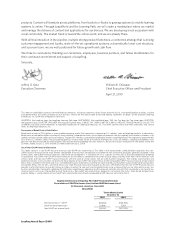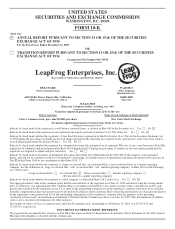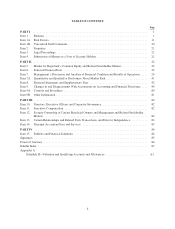LeapFrog 2009 Annual Report Download - page 15
Download and view the complete annual report
Please find page 15 of the 2009 LeapFrog annual report below. You can navigate through the pages in the report by either clicking on the pages listed below, or by using the keyword search tool below to find specific information within the annual report.
For information on sales of products that constituted 10% or more of total net sales by segment, see Note 19—
“Segment Reporting” in our Consolidated Financial Statements included in this Form 10-K.
For more information about the risks associated with our new products, particularly LeapFrog’s Learning Path
software, see Part I, Item 1A.—Risk Factors—“Our business depends on highly changeable consumer
preferences and toy trends” and “Our growing strategic focus on web-based products and customer relationship
management may not yield the returns we expect, and may limit the adoption of our products in some
international markets” in this Annual Report on Form 10-K. All references to risk factors throughout this Form
10-K are to risk factors contained herein.
Competition
Our products compete most directly in the toy industry in the pre-school toy and electronic learning aids
categories, both in the United States and in select international markets. The educational toy category continues
to attract new entrants as well as new innovative products, and competition is significant. We believe the
principal methods of competition in our industry are performance, features, quality, brand recognition, price and
learning content. We believe our learning toys, reading system, gaming platforms, and the related games and
books, compete favorably on these bases, though we are aware that our products are sometimes viewed by
consumers as premium goods, more expensive than our competitors’ products. We believe the LeapFrog brand is
recognized for quality educational products, enabling us to compare favorably with many of our current
competitors. In addition, we believe our learning toy product category is an important competitive differentiator
because it introduces parents to the LeapFrog brand and provides an entry point to Learning Path, and our
associated strategy to build direct relationships with customers.
We face the challenge of competitors introducing similar products or functionality soon after we introduce our
new products or product lines, and these competitors may be able to offer their products at lower prices using
cheaper manufacturing or materials, more limited functions, or larger volume. In addition, many of our direct,
indirect and potential competitors have significantly longer operating histories, greater brand recognition and
substantially greater financial, technical and marketing resources than us. As our competitors in the reading
systems and learning toys categories seek competitive advantages and differentiation, they are increasing their
investments in product research and development and advertising, focusing on global product launches and key
distribution channels, expansion of retail shelf space and expansion of products sold through the web. Our
principal competitors in the reading solutions and learning toy categories have included Mattel, Inc., primarily
under its Fisher-Price brand, Hasbro, Inc. and its Playskool division, and Vtech Holdings Ltd.
Our learning toy product category is important strategically because it introduces parents to the LeapFrog brand.
The educational toy category continues to attract new entrants as well as new innovative products, and
competition is significant. We believe the LeapFrog brand is recognized for quality educational products,
enabling us to compare favorably with many of our current competitors on some or all of these toy factors. As
our competitors in the reading systems and learning toys categories seek competitive advantages and
differentiation, they are increasing their investments in product research and development and advertising,
focusing on global product launches and key distribution channels, expansion of retail shelf space and expansion
of products sold through the web. Our principal competitors in the reading solutions and learning toy categories
have included Mattel, Inc., primarily under its Fisher-Price brand, Hasbro, Inc. and its Playskool division, and
Vtech Holdings Ltd.
As we pursue our strategies, we increasingly face a broader competitive arena with a variety of products
including computer products, electronic and online games and interactive gaming systems. Products in our
educational gaming category, such as our Leapster platform and related software, compete against handheld and
console-based gaming platforms from Sony, Nintendo, Apple’s iPhone and iTouch and other mobile platforms,
and against games and other software produced for these platforms. Online gaming and learning is also
increasingly becoming a factor in our competitive environment.
5
























